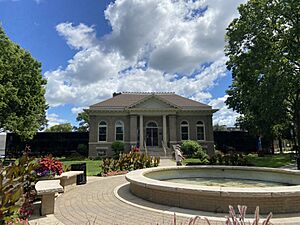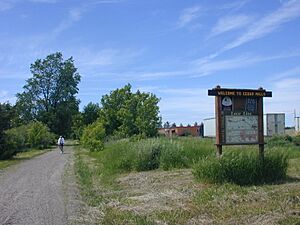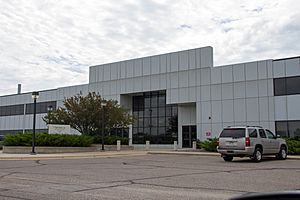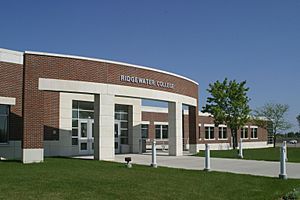Hutchinson, Minnesota facts for kids
Quick facts for kids
Hutchinson, Minnesota
|
|
|---|---|
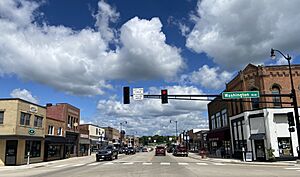
Downtown Hutchinson
|
|
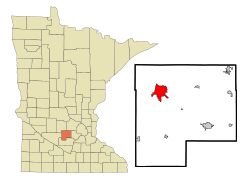
Location in McLeod County and the state of Minnesota
|
|
| Country | United States |
| State | Minnesota |
| County | McLeod |
| Area | |
| • Total | 8.82 sq mi (22.84 km2) |
| • Land | 8.48 sq mi (21.97 km2) |
| • Water | 0.34 sq mi (0.87 km2) |
| Elevation | 1,070 ft (330 m) |
| Population
(2020)
|
|
| • Total | 14,599 |
| • Density | 1,720.97/sq mi (664.43/km2) |
| Time zone | UTC-6 (Central (CST)) |
| • Summer (DST) | UTC-5 (CDT) |
| ZIP code |
55350
|
| Area code(s) | 320 |
| FIPS code | 27-30644 |
| GNIS feature ID | 2394460 |
Hutchinson is the biggest city in McLeod County, Minnesota, United States. It is located along the South Fork of the Crow River. In 2020, about 14,599 people lived there.
Contents
History of Hutchinson
The city of Hutchinson was started in November 1855. It was founded by the Hutchinson Family Singers, a famous musical group. A post office opened in Hutchinson in 1856. The city officially became a city in 1904.
In 1862, during the Dakota War, the Dakota people attacked the town. Several buildings outside the main area were burned. However, the townspeople fought back from behind a strong fence called a stockade. They were able to defend the town.
In 1942, an artist named Elsa Jemne painted a mural for the town's post office. This mural, called The Hutchinson Singers, was part of a government program. This program helped artists find work during the Great Depression. It also created public art for many new buildings.
Hutchinson used to have three different railroad lines. These railroads helped move goods and people. Over time, cars and trucks became more popular. This meant fewer people used trains for travel.
Because of this, many railroad lines were closed. The tracks west of Hutchinson were removed in 1967. The tracks between Hutchinson and Plymouth were removed in 1972. Other lines also closed in 1956 and 2001. Today, Hutchinson's old Great Northern Depot building has been saved.
Geography and Nature
Hutchinson is in the northwestern part of McLeod County. Important roads like Minnesota State Highway 7, 15, and 22 run through the city. Highway 7 goes east to Minneapolis and west to Montevideo. Highway 15 goes north to St. Cloud and south to New Ulm. Highway 22 leads southeast to Glencoe, the county seat, and northwest to Litchfield.
The city covers about 8.82 square miles (22.84 square kilometers). Most of this area is land, with a small part being water. The South Fork of the Crow River flows around the north and east sides of downtown. Otter Lake is a lake formed by a dam on the river. Campbell Lake is connected to Otter Lake.
Hutchinson is proud to have the second-oldest city park system in the United States. Only New York City's Central Park is older. The Hutchinson brothers, who founded the city, also started this park system.
Population Facts
| Historical population | |||
|---|---|---|---|
| Census | Pop. | %± | |
| 1880 | 580 | — | |
| 1890 | 1,414 | 143.8% | |
| 1900 | 2,495 | 76.4% | |
| 1910 | 2,368 | −5.1% | |
| 1920 | 3,379 | 42.7% | |
| 1930 | 3,406 | 0.8% | |
| 1940 | 3,887 | 14.1% | |
| 1950 | 4,690 | 20.7% | |
| 1960 | 6,207 | 32.3% | |
| 1970 | 8,031 | 29.4% | |
| 1980 | 9,244 | 15.1% | |
| 1990 | 11,523 | 24.7% | |
| 2000 | 13,080 | 13.5% | |
| 2010 | 14,178 | 8.4% | |
| 2020 | 14,599 | 3.0% | |
| U.S. Decennial Census | |||
How Many People Live Here?
In 2010, there were 14,178 people living in Hutchinson. These people lived in 5,950 households. About 3,642 of these were families. The city had about 1,648 people per square mile.
Most of the people living in Hutchinson were White (95.4%). Other groups included African American, Native American, and Asian people. About 3.8% of the population was Hispanic or Latino.
About 31% of households had children under 18. Many households (47.4%) were married couples. The average age in the city was 36.9 years old. About 25.6% of residents were under 18 years old.
Economy and Jobs
Hutchinson has many different types of jobs. The biggest industries are manufacturing, retail, and medical services.
Some of the top employers include:
- Manufacturing companies like Hutchinson Technology, Uponor, and 3M. These companies make computer parts, flags, vinyl, and tapes.
- Retail stores where people shop.
- Medical centers and hospitals.
- Schools and local government offices.
The city also has a company called Goebel Fixture Co. They make special cabinets for department stores across the country. Hutchinson also has strong roots in farming. For example, the Geier Hitch, a farming tool, was invented here.
The city's economy has grown a lot. It now has many local factories, shopping centers, and restaurants. There is also a hospital and medical center. They offer basic healthcare and specialized medical care.
Education in Hutchinson
Hutchinson is home to a campus of Ridgewater College. This is a college that offers both technical training and general education. It is part of the MnSCU system. The Hutchinson campus has added many "transfer" programs. These programs help students move on to a four-year university.
The college has new facilities for nursing programs. It also has modern science labs for biology, chemistry, and physics. A special program at the Hutchinson campus is Nondestructive Testing. This teaches students how to check materials for flaws without damaging them.
Besides two charter schools, Hutchinson has five public schools:
- West Elementary (Pre-K to 1st grade)
- Tiger Elementary (2nd to 3rd grade)
- Park Elementary (4th to 5th grade)
- Hutchinson Middle School (6th to 8th grade)
- Hutchinson High School (9th to 12th grade)
There are also private schools in the city. These include Maplewood Academy and Immanuel Lutheran School. Immanuel Lutheran School is a Christian school for Pre-K through 8th grade.
Notable People from Hutchinson
- Carlos Avery (1868–1930), newspaper publisher and politician
- John Bernhagen (1934–2020), politician, businessman, and farmer
- William T. Bonniwell Jr. (1836–1889), politician and businessman
- Paulette Carlson, country singer-songwriter and founder of Highway 101
- John W. Foss (1933–2020), U.S. Army general
- George P. Hammond (1896–1993), educator and librarian
- Lydia Young Hayes (1871–1943), blind educator
- Les Kouba (1917–1998), artist, author, businessman and outdoorsman
- Charles D. McEwen (1822–1901), politician
- John Jeremiah McRaith (1934–2017), bishop
- Ancher Nelsen (1904–1992), former lieutenant governor of Minnesota and congressman
- Harold Popp (1903–1969), pharmacist and politician
- Kira Sabin (born 1998/1999), wildlife painter
- Cory Sauter, retired NFL quarterback
- Lindsay Whalen, professional basketball player and Olympic gold medalist
Gallery
See also
 In Spanish: Hutchinson (Minnesota) para niños
In Spanish: Hutchinson (Minnesota) para niños


